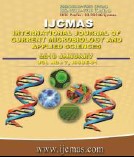


 National Academy of Agricultural Sciences (NAAS)
National Academy of Agricultural Sciences (NAAS)

|
PRINT ISSN : 2319-7692
Online ISSN : 2319-7706 Issues : 12 per year Publisher : Excellent Publishers Email : editorijcmas@gmail.com / submit@ijcmas.com Editor-in-chief: Dr.M.Prakash Index Copernicus ICV 2018: 95.39 NAAS RATING 2020: 5.38 |
The present study attempts to examine the direction and competitiveness of cotton export during pre- and post-WTO period. The time series data on export and import were collected for a period from 1977-78 to 2012-13. The study period was divided into pre-WTO period (1977-78 to 1994-95) and post-WTO period (1995-96 to 2012-13). The findings of the study reveal that during pre-WTO period Bangladesh, Portugal, Singapore, Spain, Sri Lanka, Switzerland, UAE, UK, and USA were highly unstable importers of Indian cotton. It is observed that during post-WTO period Bangladesh, Indonesia, Nepal, Portugal, Republic of Korea, Singapore, Spain, Sri Lanka, Switzerland and UAE were highly unstable importers of Indian cotton. While China and Japan were the most stable importers of Indian cotton during post-WTO period. The results of the NPC values for both the pre-WTO and post-WTO period indicated that the coefficients were less than one for all the years. It indicate that there was a more scope for export of cotton i.e. cotton was dis-protected in India. The average NPC value for pre-WTO period (0.34) and post-WTO period (0.38) indicated that the unit price of the Indian cotton in the domestic market was not much competitive in the international market.
 |
 |
 |
 |
 |